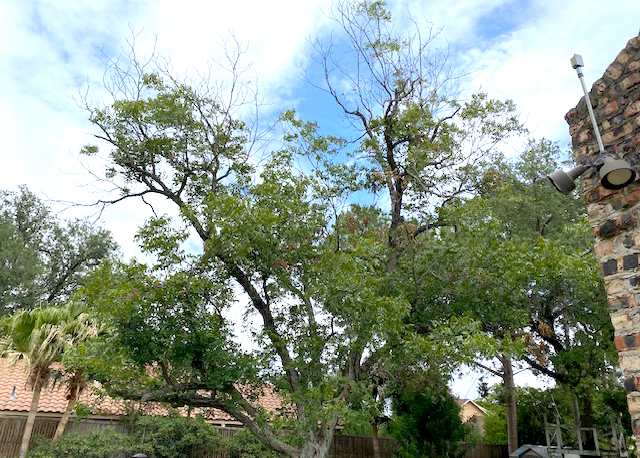Sperry: Dead branches on pecan tree a recipe for disaster
Published 5:10 am Sunday, July 13, 2025

- Dead branches on a pecan tree can be a disaster waiting to happen. (Contributed Photo)
Dear Neil: I can keep my grass green around these pecans, but we would have a huge water bill if I tried to keep the trees fully watered. I see dead/dry branches throughout our neighborhood. Should I let these pecans “self-prune” or get someone out to remove the dead wood?
It’s great that you’re concerned. It seems like so many people are not. My wife and I live beneath a forest of large pecan trees, and I can tell you from personal experience: you don’t want dead wood hanging around in pecan trees. It can fall without warning, and it’s heavy enough to cause harm and damage. Hopefully you have access to an arborist certified by the International Society of Arboriculture. Have them check the trunks of your trees for overall soundness and then prune out the dead wood. You want an arborist who has liability insurance and worker’s comp, just as protection. This isn’t a job for an ordinary “guy with a chain saw.”
Dear Neil: I bought this cactus two months ago. It was beautiful while it was in bloom, but now all the long flower stems seem to be drying up and dying. Do I cut them back? Do new ones grow out of the small “flowers” at the base of the plant? I can’t find what I should do. The label says it’s Calandrina spectabilis (rock purslane).
Trending
That’s actually not a true cactus (member of the Cactus family), but a member of the much more general category simply called “succulents” because of their ability to store water in fleshy leaf and stem tissues. As to your answer, I learned early in my career that it’s best to admit that I haven’t grown a particular plant than to prove it with a lame off-course reply. I have not grown this one, but it looks interesting.
Google it by its scientific name and you’ll find it’s native to Chile. It prefers full sun (except perhaps in the hottest part of a Texas summer afternoon). It requires perfect drainage. All references say that it blooms in spring and into the summer, occasionally again in the fall. That would explain why it has shut up shop for this season. It is listed as winter-hardy as far north as Zone 9 (South Texas). You’ll want to protect it anytime temperatures are going to drop very far below freezing. If it were mine, I would water it weekly during hot, dry spells in the summer. Oh, and to answer the question, yes, you should tidy it up by trimming off the old flower stalks. New blooms will come up from the bases of the plants.
Dear Neil: Is there a post-emergent control for yellow-flowering oxalis that I can use in a bermuda lawn in mid-summer?
Yes. You’ll want a product labeled as a “broadleafed” weedkiller. It will almost assuredly contain 2,4-D, probably along with two other herbicides in a mixture known as Trimec. I always apply it with a 2-gallon tank sprayer so that I can adjust the spray nozzle for a small droplet size just slightly coarser than a mist. I coat the leaves of unwanted weeds almost to the point of runoff. I include one drop of liquid dishwashing detergent per gallon of mix to help hold the spray on the waxy surface of the oxalis leaves. (Your identification was spot on. It’s also known as sheep sorrel.) Control with herbicides will be better when the oxalis is growing actively in spring. Do not mow for several days before or after you spray it, and do not water for 24 hours after you apply the herbicide.
Dear Neil: I’m going to be moving from Texas to Zone 5. I’d like to take a potted gardenia. How should I grow and overwinter it?
Check the plant quarantine regulations for the state where you’ll be moving. I don’t believe gardenias will show up on any of the lists, but it’s better that you find out now than once you get to the state line.
Trending
Gardenias indoors will need the brightest window in the house, a large skylight, or a greenhouse. While they do well for us in the shade in the summer, interior conditions provide far less light. Water and feed it just enough to keep it healthy and vigorous over the winter. Count on spring and summer for growth and bloom time. Protect it from freezing weather, of course. It won’t be acclimated to the cold. We’ll miss you!
Dear Neil: Is it possible to move a crape myrtle that has been in our landscape for five years now? We are adding a room, and it needs a new home.
You can try, but it’s going to be rough on it. If any plant would survive, it would be a crape myrtle. Plan on stripping all the leaves off prior to the dig but not by topping the plant. Trim off all flower heads and buds. Thin out its growth considerably by removing extra trunks to reduce its need for water. It’s going to lose a lot of roots as you move it. Soak the soil a couple of days before you make the move.
Dig it carefully with a sharpshooter spade and hold the ball of soil intact around its roots. Move it immediately to its new home and plant it at the same depth at which it has been growing. Water it deeply and thoroughly and apply a liquid root stimulator the day of the move and monthly the rest of this growing season. Water it deeply every three or four days the rest of the summer and fall.
I make no guarantee that it will survive. You would have far better chances were you to wait until winter, but that apparently is not an option. I would not even consider this for any other plant species. Crape myrtles are just extra forgiving.






